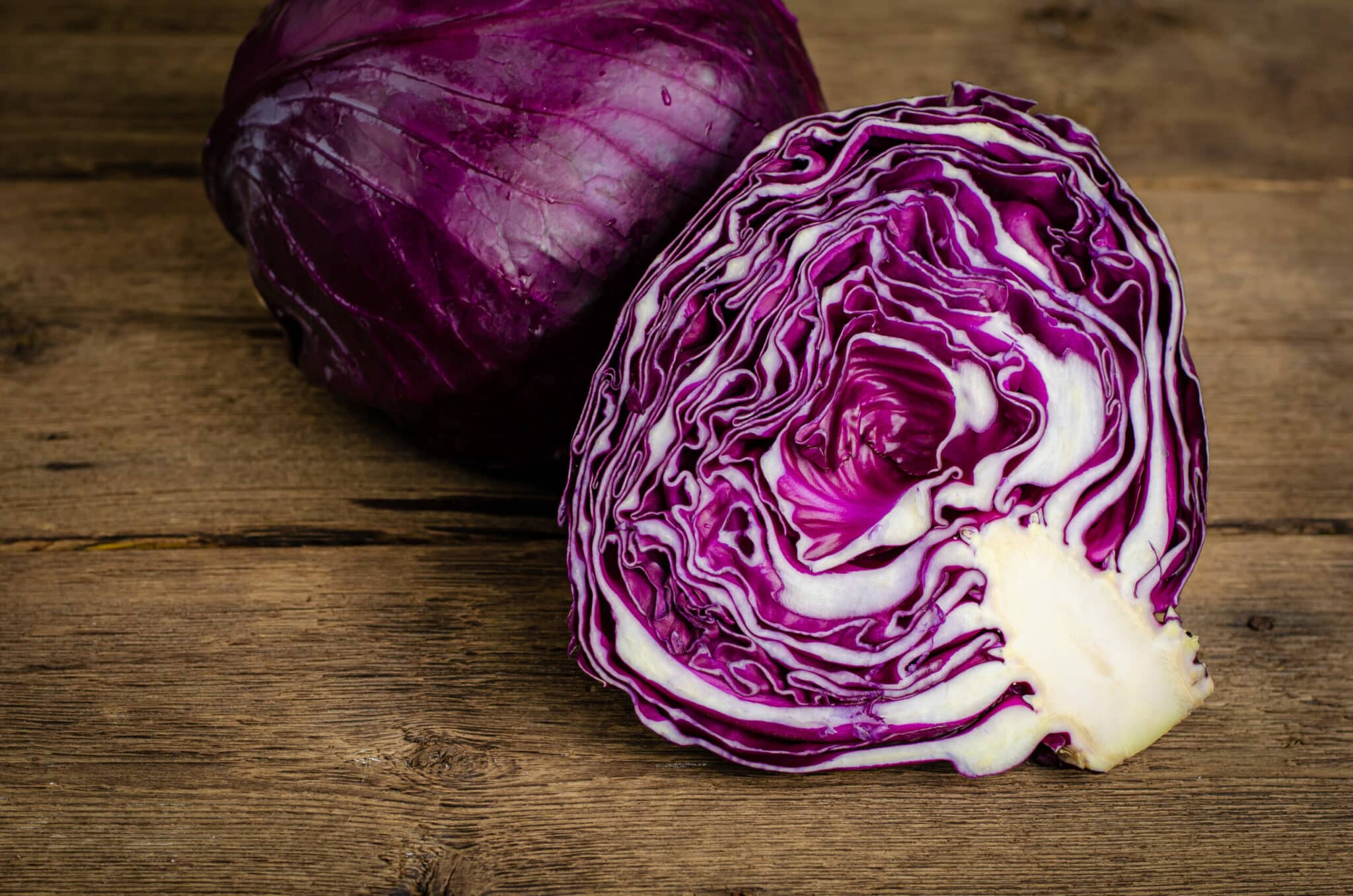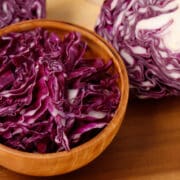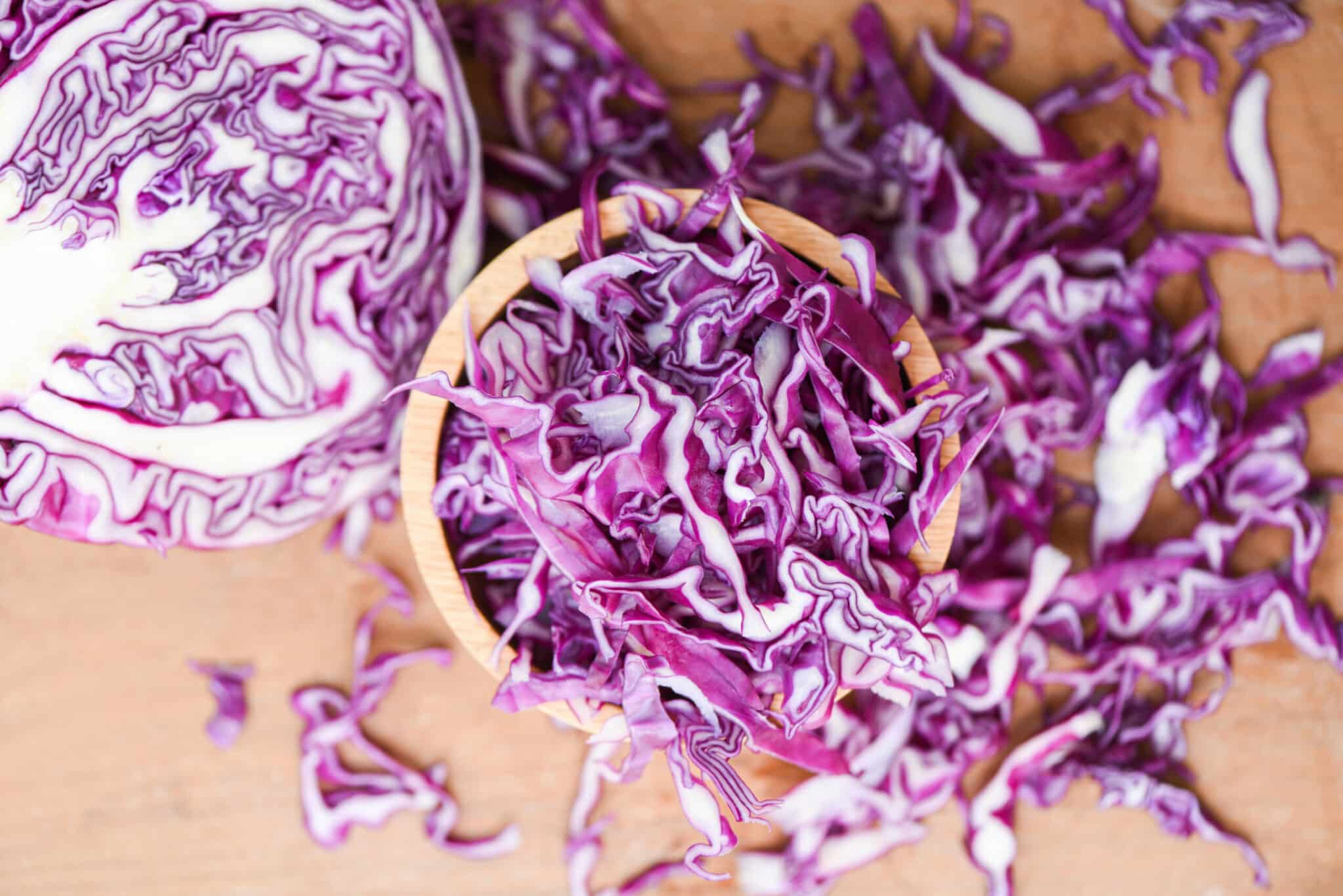Updated on June 28th, 2022
The vivid purple hue of the cabbages is possibly the most striking of all the accompaniments that grace our dinner tables.
Purple cabbage, sometimes called red cabbage, is a plant in the Brassica genus. Broccoli, Brussels sprouts, and kale are among the nutrient-dense vegetables in this class. Purple cabbage, sometimes called red cabbage, is a plant in the Brassica genus. Broccoli, Brussels sprouts, and kale are among the nutrient-dense vegetables in this class.
Purple cabbage can be cooked in a variety of ways, but the most frequent are braising and pickling. Finely shredded in salads and coleslaws or added to stir-fries, it can come out quite delicious.

Purple Cabbage Nutrition Facts

Why should you cook purple cabbage
- The purple type is high in beneficial plant components associated with health benefits like stronger bones and a healthier heart.
- Purple cabbage has also been linked to a reduction in inflammation and the prevention of some malignancies. It’s also a very adaptable vegetable that may be eaten raw, cooked, or fermented and used in a wide range of cuisines.
- Purple cabbage is low in calories but high in fiber, vitamins A, C, K, and B6, and is a rich source of iron. Other vitamins and minerals are present in modest levels.
- Purple cabbage is one of the highest antioxidant content per unit. It is also rich in sulforaphane – a sulfur-rich chemical formed when fresh cabbage is sliced or crushed. Notably, sulforaphane has been related to substantial anti-cancer and heart-health benefits.
- Purple cabbage is also high in antioxidants and other beneficial plant chemicals that can help protect cells from injury. Vitamin C, carotenoids, and flavonoid antioxidants such anthocyanins and kaempferol are among their antioxidants. In fact, it frequently contains more of them than green cabbage.
Tips on cooking purple cabbage
From September to December, purple cabbage (also known as red cabbage) is in season, though certain kinds can be harvested as early as July.
Make sure you choose purple cabbages with firm outer leaves firmly packed and substantial in weight. Light, squishy cabbages with too many outer leaves removed should be avoided.
Purple cabbages can be preserved for a week to ten days in a cold and dark place.
Try to get rid of any weary or discolored leaves before cooking. Quarter the cabbage, remove the stalks, and shred or chop the leaves.
Purple cabbage should always be cooked with a little vinegar to keep its gorgeous purple color – without it, the cabbage color may turn blue.
Braising purple cabbage is arguably the most frequent method of preparing it; it requires very little effort and has fantastic results, especially when braised gently with apples, red wine, and spices like cinnamon, cloves, nutmeg, or juniper berries.
Purple cabbage is excellent cooked sous vide because it retains its shape and structure while becoming tender.
Boiling purple cabbage is also an option. Cook it for 5 minutes in salted boiling water with a teaspoon of vinegar to keep the crunch, unless you want a softer consistency, in which case cook for a bit longer.
Purple cabbage has long been pickled as a technique to extend the cabbage-eating season, notably in northern Europe. This method allows you to utilize a range of aromatics, such as mustard seeds, star anise, cloves, or cinnamon, to infuse the cabbage. Chillis and ginge will give this wintery classic a welcome jolt of fire.
Purple cabbage can withstand a variety of flavors, including soy sauce in an Asian salad and spicy spices like cinnamon, nutmeg, cloves, and allspice. Onions, sweet apples, and raisins enhance the flavor of this earthy vegetable, which pairs well with pig, duck, venison, partridge, and sausages. Cheese, cold meats, and smoked fish go well with purple cabbage.
A traditional sweet and sour meal accompanying a roast is purple cabbage boiled with vinegar and apples. Highly flavored variations are usually encountered at Christmas parties served with turkey, goose, or baked ham.
View this post on Instagram
How to cook purple cabbage
Here’s a basic coleslaw-styled salad recipe. It is tossed in a mild vinaigrette before serving, and it can be spiced up with sesame or sunflower seeds, almonds, dried fruit, etc.
Purple cabbage contains six times the amount of antioxidants as white cabbage, so you may feel good about eating this salad on a regular basis. Enjoy the delectable recipe.
Start by halving the cabbage head along the stem, then cut each half in half again along the stem.
On the cutting board, place a quarter of a cabbage. Then cut slices ½-1 inch thick perpendicular to the stem. You should lay each slice on the board and cut it into ½-1 inch thick slices. If you want to make this process easier, try to acquire a Bornermandoline slicer.
You can pour some boiling water over the shredded cabbage in the strainer, then quickly pour cold water over it.
Then proceed to remove the water from the cabbage by squeezing it – this softens it and makes it simpler to eat. Squeeze the cabbage in your palms and place it in the bowl with the salt.
You now add the red pepper flakes, grated carrots, and celery. Then cut the onion into thin rings, then half the rings. You should also toss in the parsley and dill at this point.
In a separate bowl, combine 1 tablespoon of honey – you can opt for sugar too – 1 tablespoon of lemon juice, 1 tablespoon of olive oil, 1 garlic clove, and the pulp from ½ of the lemon.
Then you can try to toss in some salad if you fancy that – cause I do – and top with toasted sesame seeds or wheat bran. Enjoy your purple cabbage dish.
PrintHow to cook purple cabbage
Ingredients
- ½ tablespoons of unsalted butter
- 1 large yellow onion (diced)
- ¼ cup of balsamic vinegar
- 2 tablespoons of sugar
- Kosher salt
- freshly ground black pepper
- 1 head purple cabbage (halved and shredded)
Instructions
- You can start by melting the butter in a large deep skillet or cast-iron pot and then saute the onions, vinegar, sugar, and a pinch of salt and pepper for about 5 minutes, or until the onions are tender and translucent.
- You can now proceed to add the cabbage to the onion mixture and cook for 10 to 12 minutes, or until the cabbage softens and begins to brown.
- To enhance taste, you season with salt and pepper.
- Serve and enjoy
Watch this video recipe to know more about how to cook purple cabbage.

